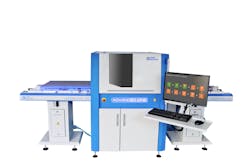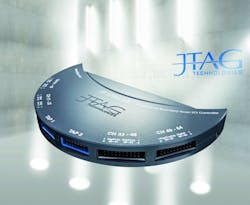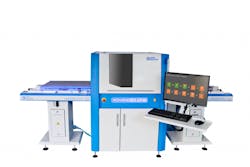Shrinking geometries pose test and inspection challenges
by Rick Nelson, Executive Editor
Effective PCB and subsystem quality depends on in-circuit, functional, and embedded test plus inspection. In the aftermath of electronica 2014 in November of last year and run-up to IPC APEX 2015 February 24-26, technologies are emerging to cope with the shrinking board and component sizes and increasing panelization that combine to pose ever more stringent test and inspection challenges.
NK Chari, director of worldwide marketing and support at Keysight Technologies’ Measurement Systems Division, highlighted trends he has seen over the past year: “At Keysight, we participate in a number of key electronics manufacturing opportunities—some of these are technology-oriented trends which have become heightened since Apex 2014, while others are market-driven trends. We see manufacturing maintaining its momentum, and we think 2015 will be a positive year for the industry as a whole.”
Growth will be driven by the notebook and mobile markets, he said, explaining that the next generation of mobile devices will increasingly contain ball-grid arrays, 3-D integrated circuits, and package-on-package devices. He added that Keysight’s embedded-test and low-access test technologies have been deployed in manufacturing to early adopters. “Our embedded test technology will become mainstream and play an important role to help customers build better quality boards,” he said, including “boards that are proving to be very tough to test with traditional in-circuit test and even imaging inspection. He added, “It’s very difficult for manufacturers to use traditional methods to find and capture defects.”
“Keysight,” he said, “has been successfully deploying a number of technologies in this space,” starting with boundary scan and adding embedded test and memory testing, to help customers diagnose boards faster. “In addition,” he said, “with the latest buzz being the Internet of Things, future products will just get more complex with microcontrollers and microprocessors going on-board, and we have the technology and capabilities to help customers move forward in this area as the markets and applications grow for the IoT.”
Boundary-scan emphasis
A company focused on boundary scan is JTAG Technologies. At electronica, the company highlighted its JTAG ProVision software suite used to support boundary-scan tests and in-system programming applications for assembled PCBs and systems. This development tool is fully automated and supports the import of design data from over 30 different EDA and CAM systems. Other key data inputs are JTAG device BSDL models and a large, well-maintained model library describing thousands of non-JTAG devices.
The company also highlighted its JTAG Live economical and easy-to-use family of board debug tools. The original offering for JTAG Live, first introduced in November 2009, included Buzz, Clip, and Script. Recently two new products were added to this family: BuzzPlus and AutoBuzz.
JTAG Technologies also showcased its JT 5705 series boundary-scan controller hardware for PCB assembly and system testing, available in desktop (Figure 1) and rack-mount configurations. The controllers incorporate both JTAG/boundary-scan controller functions and mixed-signal I/O channels. Peter van den Eijnden, managing director, said, “We have been asked to provide analog stimulus and measurements alongside more traditional digital I/O systems. The new JT 5705s provides all this and more in a really convenient and low-cost package.”
Also at electronica, GOEPEL electronic presented the RAPIDO RPS910, a new generation of systems for onboard programming of nonvolatile memories with boundary-scan/JTAG testing as an option. The RAPIDO has been developed for complex assemblies with high-density designs such as BGAs. The system offers a larger conveyer, which supports the input buffering of boards with widths up to 400 mm, thus reducing handling times. In addition, the RPS910-S32 version supports parallel processing of up to 32 UUTs or devices. Also part of the new RAPIDO is the FID module (Fixture Identification and Data), suitable for use on a mixed product line with multiple fixtures.
Augmenting boundary scan
Another company offering boundary-scan capabilities is ASSET InterTech, which has expanded beyond its initial focus on boundary scan via the ScanWorks platform to add, among other technologies, software trace and debug through its SourcePoint tools. Frost & Sullivan has recognized the value of SourcePoint and ScanWorks by awarding ASSET with a 2015 Best Practices Award for Customer Value Leadership.
Frost & Sullivan’s industry analysts based the award on in-depth interviews, analysis, and extensive secondary research comparing ASSET and other participants in the PCB design validation and test market.
“Each year we present this award to the company that has demonstrated excellence in implementing strategies that proactively create value for its customers with a focus on improving the return on investment that customers make in its services or products,” said Frost & Sullivan industry director, in a press release. “The award recognizes the company’s inordinate focus on enhancing the value that its customers receive.”
Glenn Woppman, ASSET’s president and CEO, said, “Weve been able to organically enhance the value of our technologies by internally adding new innovations to our ScanWorks hardware validation and test platform and by adding to our solutions through the acquisition of the SourcePoint software debug and trace platform. This combination of software and hardware tools is what sets us apart because it allows our users to bring their products to market much sooner.”
Optical inspection
After electronica, GOEPEL announced that it offers a new variant of its Advanced Line inline AOI system (Figure 2) for the inspection of over-length PCBs. The longboard AOI system enables testing of assembled and soldered PCBs with a length of up 1,600 mm, with an adjustment for even longer PCBs is also possible. A usage case example would be quality control of lighting-module subsystems used for cabin lighting in passenger aircraft.
The system is available in a variety of speeds. It can be configured with the rotating angled-view Chameleon module and a laser height measurement system. Integration of the additional 3D•EyeZ measuring module allows three-dimensional measurements of solder joints and components. PILOT 6 system software is also available for the longboard AOI.
AOI systems from GOEPEL electronics can be used for automatic inspection of assembled PCBs, both before and after soldering process. Stand-alone and inline versions are available. The modularity and flexibility of the systems allow optimal adaption to the specific conditions of the manufacturing production process. Features are the patented 360° inspection and unique multispectral illumination.
Also addressing inspection is Koh Young Technology, which recently debuted the KSMART Integrated Technology Solution, a productivity and process control center. KSMART results from the convergence of Koh Young software technologies working in concert with 3D AOI and SPI capabilities.
These technologies include the KSMART Remote Monitoring System (RMS), KSMART Link, and others, which will be added to KSMART as they are developed.
The company defines the KSMART Solution as its long-term vision to help customers realize maximum production efficiency and control for today’s advanced electronics manufacturing. Koh Young Technology’s KSMART Solution comprises an easy-to-use, integrated toolbox that enables real-time analysis of defects. It provides 3D inspection data obtained from Koh Young’s 3D inspection systems to help find root causes of defects and achieve process optimization. Further, t provides the ability to control multiple inspection systems with standardized conditions and recipes.
KSMART Remote Monitoring System (RMS) is the first software product in the KSMART solution. KSMART RMS communicates with all Koh Young SPI and AOI machines in multiple production lines, obtaining the machines’ status, production-line yield information, and real-time defect information to enable efficient operation. Factory managers can track root causes of defect issues and apply changes to inspection programs in real time. Real-time defect information is also shared with remote operators who can confirm the information. KSMART RMS will be followed by KSMART Link, which will allow customers to analyze all 3D inspection results from Koh Young 3D SPI and 3D AOI systems.
Bed-of-nails and flying probes
In related PCB test news, Seica is bridging the gap between bed-of-nails and flying-probe test with its new Pilot4D FX platform, designed specifically to test panels. The Pilot4D FX system provides the capability to share test resources, moving a small, low-cost fixture from one board to another, effectively eliminating the need to duplicate them in the system.
The mechanical architecture of the system allows the test head, which carries the fixture, to rotate in order to accommodate any configuration of panel layout, and the Pilot4D FX is fully implementable in an automated production line. The Pilot4D FX system features the core performances of the Seica VIP test platform, including hardware and software scalability.
The Pilot4D FX uses a color camera which, in addition to fiducial centering, is able to acquire the serial number of each single board within the panel. An integrated marker is available to mark the tested boards, according to user-defined rules. Seica’s VIVA test software is able to communicate with external databases, enabling full integration of the Pilot4D FX system into the user’s own production management environment.
The Pilot4D FX employs a 19’-inch rack to enable the integration of external instrumentation. It also integrates on-board-programming (OBP) modules as well as sensors for LED test applications. It also supports boundary Scan test and communication management via standard protocols (for example, CAN and LIN).
Planning for in-circuit, functional, and JTAG test
Looking ahead, Chari at Keysight said his company is investing in its 3070 platform, resulting in release 9.0 of the in-circuit test system’s software. “We are not only improving the throughput by enabling concurrent test technology, we are also introducing Phase One of our modern user interface, which will help test engineers with their test development faster than ever before,” he said. “Keysight is also improving the test development software for our recently introduced i1000D small-footprint and inline ICT solution to help make test development even faster.”
He added, “The second area in which we are investing energy is improving our boundary-scan platform with multiple releases over the coming year to help customers have an even more complete suite of solutions and applications, such as solutions for SSDs for notebooks and tablets, with the x1149 platform as the centerpiece.”
Keysight is also addressing functional testing with new introductions like the M9188A, a PXI-based, 1-slot unipolar dynamic D/A converter, which has 16 channels. “In the mechatronic high-voltage-test market,” he said, “due to the lack of options, customers often have had to adopt low-voltage DAC solutions by adding custom signal conditioning, slowing down development time and increasing cost. We believe the M9188A Dynamic DAC perfectly fits the need to simulate signals such as wheel speed sensors for automotive applications and other high voltage applications, including aerospace and defense.”
For more information:
See these related articles:
- IJTAG interoperability brings value to chip and board engineers
- JTAG Technologies plans for Apex Expo
- Laser systems to debut at IPC/APEX Expo
- Digitaltest to highlight flying-probe and combinational test
- GOEPEL debuts test and programming strategies for Bay Trail processors
- Congressman Mike Honda visits Hunter Technology Corp.
- Flying probe PCB tester achieves high throughput
- Connor Solutions adopts Aegis FactoryLogix software
- SEMI, IPC praise passage of manufacturing innovation act
- IPC faults EPA’s Definition of Solid Waste rule
- Board test in a repair depot: bridging past and future
- Seica plans for IPC Apex Expo
About the Author

Rick Nelson
Contributing Editor
Rick is currently Contributing Technical Editor. He was Executive Editor for EE in 2011-2018. Previously he served on several publications, including EDN and Vision Systems Design, and has received awards for signed editorials from the American Society of Business Publication Editors. He began as a design engineer at General Electric and Litton Industries and earned a BSEE degree from Penn State.


